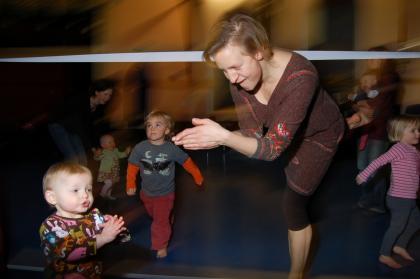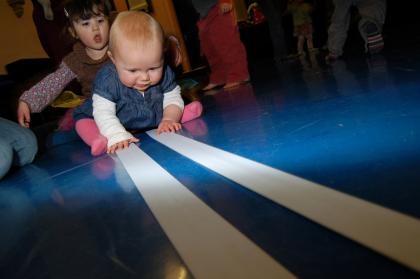Artists Interviews
September 2011: Corina Chiran
Introduction

Our Guest Editor for August-September, Corina Chiran, interviewed Hannah Lefeuvre, a dance artist who works with children under 5.
About the artist
Hannah Lefeuvre is an experienced dance artist. Since 2009 she has devoted her time to working with under-fives, exploring dance, movement and the imagination in various venues. Hannah was a lead creative practitioner on Little Big Bang, a two-year research project in Somerset, and has since worked in India. She is currently studying for an MA in New Leadership in the Early Years with Canterbury Christchurch University.
http://takeart.org/resources/profile/hannah-lefeuvre/
About the project
Do you think that you need specific artistic preparation / inclination for understanding the early years?
I believe an artist needs an instinct for early years initially and I think it requires a certain approach. Early Years children are very immediate. They let you know when they’re not interested (by walking away or telling you) and they also pick up on adult emotion. For example, they are much more sensitive to facial expression, tone of voice and body language. The work is not necessarily linear. I find it very lateral and often episodic. So the artist needs to be open to go with the child’s flow, whilst keeping the thread of a workshop and extending the play / activity.
Why is it important for very young children to engage with professional arts practice?
Working with professional artists gives to the children a chance to extend their thinking and nurtures their natural curiosity and creativity. It is also important for parents to engage, to understand the benefits and have confidence for their child to do something creative. I have encountered many parents who have certain pre-conceptions about the arts. So we need to make it accessible to everyone.
It’s important for children to experience professional arts practice before they get to an age of being ‘bad’ or ‘good’ at something and before they start to want to fit in with others. Creative arts practice is holistic and covers all areas of learning and development. In terms of dance, it covers physical, social / emotional, mental and creative development.

Thank you to Richard Tomilson and Take Art for the images
Why did you choose to work with this age group?
I have always found an affinity with this age group and have worked with early years children since my teens. I didn’t pursue it as a career initially, because at the time, it was not a viable option. Fortunately, things have progressed since then in the UK. The early years is becoming a reputable career and the engagement of the arts sector is currently strong. So now I can combine my two passions: dance and early years children.
I love this age group for their playfulness, openness, sensitivity, instinctive movement, ideas and imagination. I learn a lot from early years children and they feed my own creativity. Generally, I find them non-judgmental, honest and grounded and a daily reminder of the good aspects of humanity. I am excited by the potential of being part of the beginning of a person’s life, in years that are so crucial and formative. I believe that if we can instill hope, faith, kindness and confidence in our early years children, and encourage their individual skills and offers, this will set a person up for life and feed our future.
I know your workshops are fabulous. Do you have an amazing memory that you can share with us, from one of your activities?
I had some very inspiring sessions collaborating with a visual and environmental artist. We flowed together and with the children for several hours, beginning with great big lengths of bamboo and a few logs, creating birds, hoops, trails, dens, collages, canvases, decorating a tree and creating a whole story and movement journey together.
Otherwise, no one particular moment stands out. It’s often an idea, a comment or a moment of particular progress, which is significant. I like to work with groups over an extended time, say 1, 2 or 3 years, which might span babyhood to toddler, toddler to pre-schooler. Then I can really get to know their needs and preferences.
For example, in one group, I would bring in a few items, ask the children where they wanted to go today. We would problem-solve our way there together, think up activities to do there and then get back home again. They moved a long way in their confidence and imagination, from their first session as toddlers, where they were shy, hesitant and not forthcoming with ideas. In another group, of parents and children, we decided on one occasion to take our adventures into some local woods. We continued our subsequent 6 sessions in the woods, with stories extending for 1½ hours.
I travel a lot interacting with many nationalities and I know you do the same. I am curious to know if there are any differences in children’s expressions of joy or in their reactions to the arts experience around the world.
I didn’t get enough time in Spain to explore the work fully and my time with the children in India is very brief (just one month). In India, I am working in just one part of Kolkata, a hugely diverse city and phenomenally rich and complex nation.
However, so far, I have observed some fascinating cultural differences in the approach to the Early Years. For example, in a school for slum children, the 2,3 and some 4 year olds children are left to roam, for ‘free play’. I observe them fighting, wriggling, running nowhere and being very bored, but not playing. They are scolded by older children and staff for getting in the way, being in the wrong place, having access to something they’re not allowed and so on. So they have nothing to play with and no one to role model. Similarly, in street children, I observe a lot of fighting and general restlessness, but not play. (I am informed by colleagues here that children are more playful in the rural areas, where it’s safe to play. In a city like Kolkata, it is unsafe to play on the road sides and children need to be streetwise for survival.)
So the work I am doing here has been very tentative. There seems to be a perception in slum cultures that small children get in the way, waste resources and shouldn’t be trusted with things and this is reflected by the older children at the school and some of the more elderly staff, who come from the community.
I have focused my attention on these 2 and 3 year olds, working in one tiny area of a classroom, shared with two other classes and shielded by a screen. We have no means of playing recorded music, so my first approach has been to introduce play, using resources which are not seen as precious and which the children and staff can access when I leave. For example: cardboard boxes, newspaper, water play, plastic bottles, string and using our own bodies as our greatest resource.
Once I introduce an idea, the children are incredibly responsive, imaginative and bright. Without any common language, we play together for hours. At the age of 4 or 5, the children are already learning by rote, with immaculate exercise books, containing drawings of westernised houses, trees, boats etc. So with these children, they also soak up everything, but through copying, learning songs and movements quickly, without contributing their own ideas.
I have other observations, but the study of arts practice for early years children in India is vast in scope and hugely complex, with children receiving a huge range of early experiences, according to caste, class, location and teaching. I would welcome dialogues with others who have explored such work in India.
Comments about this interview
Post your comment!
To comment this interview you must be logged.
- Guest Editor Katy Fitzpatrick on Bolthole by Rhona Byrne
- Art and Philosophy in the Classroom by Guest Editor Katy Fitzpatrick
- Jennie Guy in conversation with Guest Editor Katy Fitzpatrick
- Anne Bradley in conversation with Katy Fitzpatrick
- Priscila Fernandes in conversation with Katy Fitzpatrick - audio interview


No comments added